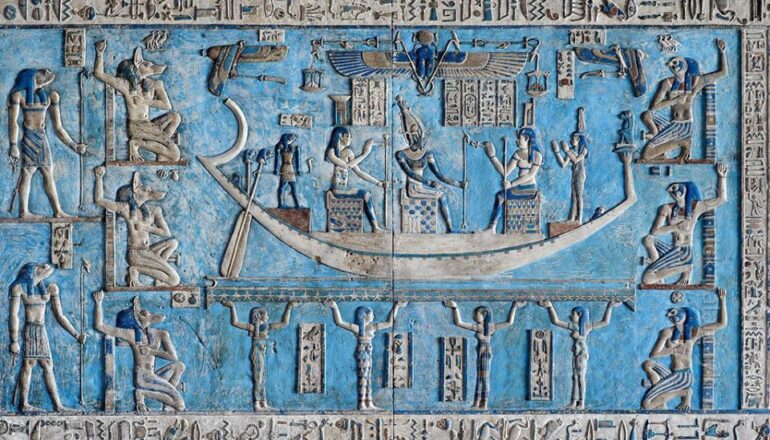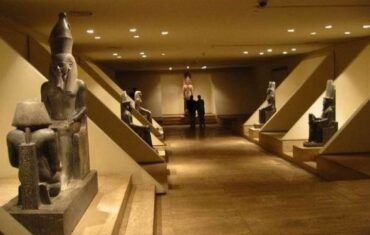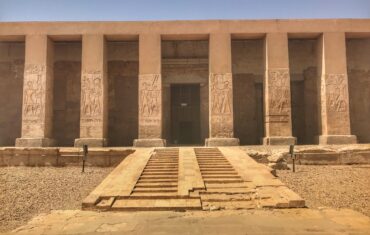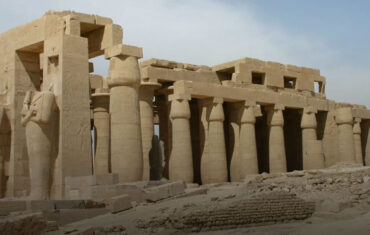History of the Temple of Hathor
Although shrines of Hathor, the goddess of joy and pleasure, have existed in Dendera since pre-dynastic times, the existing temple of Hathor is a work of the Greco-Roman era, built between 125 BC and 60 AD. Although the construction was carried out in order to assert the legitimacy of the power of foreign rulers in ancient Egypt, the temple follows the ancient Egyptian pattern with its series of hypostyles and vestibules leading to the dark sanctuary and visibly embodying “the transition from the bright light of the Egyptian sun to the mystery enclosed in the Holy of holies” (T. James).
The temple facade is a pylon with six Hathoric columns rising above the wall. Both outside and inside, Hathor is more often depicted in human form, rather than in the form of a cow. Since this part of the temple was built during the reign of Tiberius, the reliefs depict Roman emperors offering gifts to the gods, namely Tiberius and Claudius in front of Horus, Hathor, and their son IHI, and Tiberius in the form of a Sphinx in front of Hathor and Horus. In the engravings of the XIX century, you can see that the temple was covered with sand almost to the lintel of the portal, so it was the upper part of it that took the brunt of Coptic iconoclasm.
The Cult Of Hathor
Hathor, worshipped in the form of a cow since ancient times, gradually acquired many hypostases – the celestial goddess, the living soul of trees, the mistress of gold and turquoise, the patroness of music and feasting-but in fact remained a wet-nurse goddess. Its most important role in mythology is that of the nanny of Horus and the wet-nurse of the living Pharaoh. It was believed that in her human form (with cow ears and horns), the goddess made an annual visit to the choir in the temple of the IDF. Accompanied by the priests and cheered by the common people, her barge moved slowly upriver, and the Chorus sailed to meet her in its own boat.
After the lavish ceremony, the statues of the gods were “left alone” to renew their nuptials, while the crowd paraded at the festival of Hathor (the festival of intoxication), because of which the Greeks identified Hathor with their own goddess of love and joy-Aphrodite. However, in other times, drunkenness was condemned, as can be seen from the text that does not lose its relevance, condemning the hooligan: “You may wonder about the streets reeking of alcohol; people have seen you perform tricks on the city wall; people are fleeing from the blows of your fists. You should look at yourself when you’re pounding your stomach with your fists or rolling around on the ground covered in your own filth!”
Hypostyle of the temple of Hathor
When you enter the hypostyle of the temple with its eighteen Hathoric columns, give your eyes time to adjust to the gloom, and only then begin to examine the famous ceiling with its astronomical images, which in many places retain their original colors. This is not a map of the starry sky in the modern sense of the word, but a symbolic representation of the celestial bodies, the hours of day and night, and the spheres of the dominion of the sun and moon. Although due to the Kens bend, the temple is oriented from North to South, rather than along the usual West-East axis (Egyptian temples always faced the Nile), the traditional division of the sky into Northern and southern halves is preserved in the ceiling painting.
Above the central aisle, there is a row of flying vultures and winged disks, which separate the left part of the ceiling, representing the southern side of the sky, from the right, dedicated tonight. The first row of figures begins with the image of the Eye of RA in the rook, above which are placed the figures of the fourteen days of the waning moon. The image of the full moon in the center is followed by the fourteen days of the waxing moon (each of them had its own deity), the complete lunar disk, which is worshipped by Thoth, ends the sequence, and finally the image of this celestial body in the form of Osiris, who is guarded by ISIS and Nephthys. Souls in the form of jackals and birds adorn the rook of RA during its journey across the Sunnyside of the sky.
The next two registers show the planets, the stars of the twelve-night hours, and the signs of the zodiac (borrowed from Babylonia). The farthest sections are occupied by the image of Chickpeas, which gives birth to the sun at dawn and swallows it at sunset. On the one hand, the birth of the God of the rising sun – Khepri (scarab beetle) is depicted, on the other-the sun’s rays descend on Hathor.
Hall of phenomena of the temple of Hathor
The Hellenistic part of the temple opens with a columned hall of phenomena, where Hathor is depicted together with other gods, before its departure to the IDF. By the light of a torch, you can see reliefs on the entrance wall with scenes of the offering of gifts, the Foundation of the temple, and its dedication to the gods. Pay attention to the” empty “cartouches, which indicate the” turnover of personnel ” in the ruling circles of the Hellenistic era.
The stonecutters didn’t want to waste their energy on inscriptions with the names of kings who might soon lose their throne, and they might not even know who was currently ruling in Alexandria– those were the days. However, religious rites continued to be performed in Dendera, the priests still kept sacred objects made of precious metals in the Treasury and took water for ritual ablutions from a well, which can be accessed through the so-called Nile Hall.
Symmetrical rooms on the opposite side of the hall of phenomena include a laboratory where perfumes, incense, and ointments were prepared and stored (note the reliefs with recipes and images of servants bringing exotic ingredients) and another room for storing valuable items. On the inside of the front wall of the hall is a cult calendar, which lists the festivals that took place in the temple.
Hall of gifts and Hall of Ennead of the temple of Hathor
Then there is the hall of gifts, which forms the entrance hall of the temple in the proper sense of the word. From here to the roof lead two stairs, which were taken out of the sacred animals. On the back wall is a list of gifts on the opposite wall of the corridor – a relief with the image of the king offering Hathor her favorite drink.
Then we come to the Hall of the Ennead, where once stood statues of gods and kings who participated in ceremonies in honor of Hathor. The goddess’s wardrobe was kept in a room on the left, with reliefs on the walls depicting priests carrying caskets of sacred vestments. On the outside of the sanctuary wall, you can see the texts of the “hymns of awakening”.
In the sanctuary, itself stood a statue of Hathor and a ceremonial boat, which the priests carried to the river and placed on the ship. Worshippers of the goddess then towed it upriver to IDF, where Hathor was married to Horus. The reliefs depict daily rituals (described in connection with the temple at Abydos) and the king presenting a statuette of Maat to the gods – Hathor, Horus, and Harsent, or Horus Semataui (back wall)
Side chapels of the temple of Hathor
Two corridors with side chapels run along with the sanctuary, joining behind it. Above the door to the corridor of the mysteries, Hathor is depicted in the form of a cow, standing inside a wooden ark on a boat. Over the chapels of ISIS, the Sacred snake Sokara and you will find “House of the Sistrum” (the sistrum is a musical instrument of Hathor), here are the niches depicts Hathor as the goddess of the sky and IHI in the incarnation of the God of music. The room is accessed through Per-Nu’s dark oratory, from where Hathor went on her nuptial journey to the IDFU during the new year celebration (which in ancient times fell on July 19).
The new year’s procession left the Per-Ur chapel, from which you can now climb a rickety staircase to a small room with relief images of Hathor, Maat, and ISIS. In the Per-Nesser chapel, the caretaker will open a trapdoor in the floor and take you down to a low-ceilinged crypt decorated with carvings of cobras and lotuses (don’t forget to pay baksheesh). In the chapel itself, Hathor is depicted in its most formidable guise – in the guise of a lioness, since by the time of the Ptolemies, it had become identified with the lioness goddess Sekhmet and the cat goddess Bastet. The most valuable property of the temple was stored in a room under The RA chapel.
If during your tour you didn’t accidentally come across the so-called “place of purity” – a new year’s chapel with a relief on which the goddess Nut gives birth to the sun shining over the head of Hathor-go back to the Hall of the ENNEAD, go left to the front room and then turn right. It was here that the rites leading up to the ceremony of Hathor’s reunion with the sun, which was held on the roof of the temple, were performed.
Prayer houses on the roof of the temple of Hathor
On both sides of the hall of gifts are stairs leading to the roof of the temple; on the walls, there is a new year’s procession, during which the statue of Hathor was carried up in an open ark, where it waited for the dawn. The rays of the sun, touching the statue, enlivened the BA (soul) Hathor for a new annual cycle. Next to the pavilion of the sun, behind the facade of the hypostyle, there are two rows of rooms associated with the death and resurrection of Osiris. Though chapels on a roof existed in the majority of temples, in Dendera they have survived undamaged.
The chapel on the left (if you are facing South) is notable for reliefs on the inner walls: ISIS and Nephthys mourn for Osiris, Osiris passes through the gates of the underworld, and finally, Osiris impregnates ISIS, depicted as a soaring bird of prey. Another Suite of rooms is decorated with a plaster copy of the famous zodiac ceiling of Dendera, taken by Lelorren in 1820 and now stored in the Louvre.
The zodiac circle, supported by four goddesses, differs from our own only in the presence of a scarab in place of a Scorpion and the hippopotamus goddess Tauret. The Egyptians (as well as the inhabitants of other countries) learned about the zodiac from the Romans, who themselves borrowed it from the Babylonians. Be careful, the room has a low ceiling!
The most striking impression is the majestic view of the temple complex and surrounding area, opening from the roof. Note also the inscriptions left by French soldiers in 1799: among them are the names of the commander Desaix and the artist Denon, who, while at Dendera, continued to make sketches in the face of the advancing Mamluks; when he ran out of slates, he made lead pencils out of bullets.
External buildings of the temple of Hathor
The temple was surrounded by various buildings, which are now mostly destroyed. A distinctive feature of Hellenistic temples was the Mammizi, or “house of birth,” in which the king was worshipped as Horus, the divine ruler. When the Romans built a wall around the temple, it divided into two parts the “birth house” of Nectanebus (XXXTH dynasty) and had to build a new structure of the same type.
On the southern wall of the” birth house ” of the Roman period, there are several elegant reliefs, and the capitals of the columns and architraves are decorated with tiny figures of Bas and Tauret. Between the two Mammisis are the ruins of a Coptic Basilica of the fifth century, built from stone blocks borrowed from neighboring buildings. Note the carved Coptic crosses.
The merciful Hathor was considered a healing goddess, and her temple was visited by pilgrims suffering from various diseases. In the temple sanitarium, they received prescriptions for healing during sleep, possibly caused by drug intoxication. Water for ritual ablutions was taken from a sacred lake, later dried up and overgrown with palm trees, among which birds are abundant. Nearby is the ruined temple of ISIS, where ISIS and Osiris were worshipped. It was built by Cleopatra’s worst enemy, Octavian after he became Emperor Augustus







